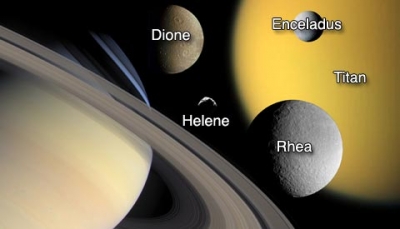
While Jupiter is known for its four large Galilean moons (so named because they were observed by Galileo with his 17th century telescope), Saturn has two moons that have drawn astronomers’ attention: Enceladus and Titan.
Both Enceladus and Titan are ocean moons, meaning they have subsurface oceans of liquid water. Titan even has surface lakes, though these are composed of methane and ethane. Enceladus is an icy moon known for spraying huge plumes of water up through its atmosphere into space; during the Cassini mission, astronomers were able to sample these geysers and that’s how they discovered the ocean underneath its icy crust.
Enceladus is named after a giant in Greek mythology.
Pictures from the Voyager spacecraft in the 1980s indicated that although this moon is small—only about 310 miles (500 kilometers) across — its icy surface is remarkably smooth in some places, and bright white all over. In fact, Enceladus is the most reflective body in the solar system. For decades, scientists didn’t know why.
Because Enceladus reflects so much sunlight, the surface temperature is extremely cold, about minus 330 degrees Fahrenheit (minus 201 degrees Celsius). But it is not as cold and inactive a place as it appears.
Titan is larger than the planet Mercury and is the second largest moon in our solar system. Jupiter’s moon Ganymede is just a little bit larger (by about 2 percent). Titan’s atmosphere is made mostly of nitrogen, like Earth’s, but with a surface pressure 50 percent higher than Earth’s. Titan has clouds, rain, rivers, lakes and seas of liquid hydrocarbons like methane and ethane. The largest seas are hundreds of feet deep and hundreds of miles wide. Beneath Titan’s thick crust of water ice is more liquid—an ocean primarily of water rather than methane. Titan’s subsurface water could be a place to harbor life as we know it, while its surface lakes and seas of liquid hydrocarbons could conceivably harbor life that uses different chemistry than we’re used to—that is, life as we don’t yet know it. Titan could also be a lifeless world.
Credit : NASA Science
Picture Credit : Google




